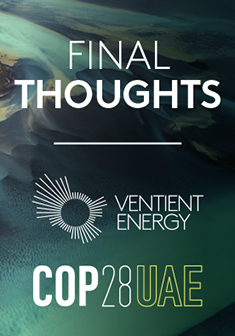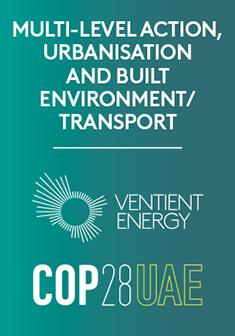We are facing an ecological “polycrisis”
The 2023 Global Risk Report[i] published by the World Economic Forum warns that the world is hurtling towards an era of “polycrises”, meaning multiple interconnected crises happening at the same time. According to this study, the highest risks threatening humanity over the next ten years are the interlinked climate and nature loss crises – and, despite being the two greatest threats of our time, these are the two threats that humans are least prepared for.
By now, we are accustomed to “empty words” on climate change, but the situation is even worse when it comes to nature loss, where, until recently, there have been very few words spoken at all. This is particularly concerning as we are currently racing towards what some people are calling “the sixth mass extinction”, with one million animal and plant species under threat – more than at any other point in human history[ii]. The climate and nature loss crises are ecological issues at their core, but their far-reaching economic and social impacts are also impossible to ignore. According to the World Economic Forum[i] “over half of global GDP is dependent on nature” meaning that nature loss on the scale we are witnessing is a serious threat to economic resilience.
The COP28 thematic day dedicated to Nature, Land Use & Oceans must treat climate change and biodiversity loss as a “polycrisis”, interlinked in both its causes and solutions. We will be watching closely for interlinked solutions that achieve a climate-safe future, while halting and reversing nature loss and building economic resilience.
Climate change is a leading cause of nature loss
Human activity is responsible for the major decline in nature that we are experiencing, with , pollution, exploitation of natural resources, and introduction of invasive species, all playing a part. The most immediate threat to nature is land use change, which is when human activity transforms natural ecosystems to alternative land uses (e.g., the conversion of forests into agricultural land). The prognosis is bad even before we add climate change into the picture, which is expected to become the leading driver of nature loss as it intensifies over the coming decades. Today, we are already observing climate-induced nature loss:
- In terrestrial ecosystems, some animals and plant species are migrating to higher elevations and towards the poles to escape rising temperatures. It is predicted that this will cause new species to come into contact for the first time, increasing the chances of viruses and diseases crossing between animals and into humans.
- In marine and coastal ecosystems, rising temperatures have been causing irreversible damage, and one of the starkest examples is the loss of coral reefs. The world has already lost 27% of its coral reefs and the World Wide Fund for Nature[iii] estimates that a further 33% will be destroyed over the next 30 years.
Nature positive solutions mitigate climate change
To solve a “polycrisis” requires a “polysolution” – and when it comes to nature, this means we can use the same resources to tackle both threats. Paradoxically, by irreversibly damaging the Earth’s land and oceans, we are jeopardizing our greatest resource for fighting climate change. According to the UN Environment Program[iv], nature is a vital carbon sink, capable of absorbing about one-third of the greenhouse gas emissions needed in the next decade to achieve the goals of the Paris Agreement. However, this is only possible if we urgently stop destroying natural ecosystems and pursue all efforts possible to reverse the damage that has already been inflicted.
Forests, grasslands, heathlands, wetlands, and marine ecosystems are all capable of absorbing and storing carbon in biomass and soil, some more so than others. Peatlands are a particularly valuable resource in preventing historical greenhouse gas emissions from entering the atmosphere. Despite covering only 3% of the Earth’s land[v], these terrestrial wetland ecosystems store twice as much carbon as all forests combined. Peatland plants absorb greenhouse gas emissions slowly over time through photosynthesis, and the waterlogged and anaerobic conditions cause this carbon to become trapped almost indefinitely. However, if peatlands are disturbed and degraded, they can shift from a valuable carbon store to a hugely problematic carbon source, and this is what we are observing today. Many of the world’s peatlands have been degraded by human activity (e.g., draining, removing, or burning peat) and so are actively contributing around 5% to global anthropogenic carbon emissions.
In 2020, a fifteen-year Section 75 planning condition at Causeymire Wind Farm, in Caithness, was successfully discharged by Ventient Energy. A report[vi], authored by Dr. Tom Dargie of Boreas Ecology (an international expert of peatlands) found significant environmental improvements on a 1129 hectare (ha) Habitat Monitoring Survey Area surrounding the wind farm (within the survey area, a Habitat Enhancement Area of 7.7ha was identified for remedial measures). The study found a fourteen-fold increase in sphagnum moss (11% – 48%) across the entire area, 7.7ha of bare peat was eliminated and as a result of this bird surveys found a greater level of activity of a number of key bird species.
Karl Parker, Assistant Project Manager at Ventient Energy, said: “NatureScot estimate 80% of Scottish Peatlands are damaged, assessing peatland habitats accurately offers a range of benefits allowing for peatland restoration. At Ventient Energy we are committed to ensuring we maintain and increase biodiversity at our sites and ultimately leaving our sites in a better environmental state than they were found for all generations to enjoy”.
COP28 needs to deliver “polysolutions”
Last year, the UN Biodiversity Conference (COP 15) reached a landmark agreement to halt and reverse global nature loss, resulting in the adoption of the Kunming-Montreal Global Biodiversity Framework[vii]. Although long overdue, this should be celebrated as a significant step forward in elevating the importance of nature loss on a global stage. The framework sets out an ambitious pathway to a world living in harmony with nature by mid-century. It implements global targets for 2030 and 2050, including protection of 30% of the planet for nature and restoration of 30% of the planet’s degraded ecosystems by 2030.
Now that the foundations have been laid by the Global Biodiversity Framework, COP28 provides an opportunity to maintain momentum on the targets of COP15, while shining a spotlight specifically on the links between climate change and nature loss. The thematic program at COP28 is designed to treat climate change as a “polycrisis” interacting with nature loss and economic resilience, amongst other issues. A key indicator of success of the Nature, Land Use & Oceans Day, and indeed the wider COP28 agenda, will be ensuring that climate change is not considered in a vacuum. We need “polysolutions” that tackle the climate crisis alongside other major threats to people and the planet.
Holly Backhurst
ESG Manager
Sources
[i] Global Risks Report 2023, World Economic Forum – https://www.weforum.org/publications/global-risks-report-2023
[ii] Global Assessment Report on Biodiversity and Ecosystem Services, IPBES – https://www.ipbes.net/global-assessment
[iii] Living Planet Report 2020, WWF – https://www.wwf.org.uk/sites/default/files/2020-09/LPR20_Full_report.pdf
[iv]Nature for Climate Action, UNEP – https://www.unep.org/resources/factsheet/nature-climate-action
[v] Global Peatlands Initiative – https://globalpeatlands.org/
[vi] Ventient Energy – https://www.ventientenergy.com/news/2020/11/19/causeymire-study-reaches-positive-conclusion/
[vii] Kunming-Montreal Global Biodiversity Framework, Convention on Biological Diversity – https://www.cbd.int/gbf/


More articles


COP28 - What happened and was it a success?
Last week we saw COP28 come to a close, and, as President Sultan Ahmed Al Jaber dropped the final hammer of the conference, it’s fair to say there were some mixed emotions regarding the outcome. Over the last 8 weeks, we have been following…


Multilevel Action, Urbanisation and Built Environment, Transport
“Today, 55% of the world’s population lives in urban areas, a proportion that is expected to increase to 68% by 2050”. The UN. This increase, known as ‘urbanisation’ brings with it a series of challenges as we grapple with increasing…


